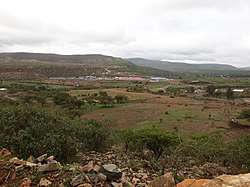Lake Giba
Lake Giba is a reservoir under construction at the border of the Inderta; Kilte Awula'ilo and Dogu’a Tembien woredas of the Tigray Region in Ethiopia.[1] The earthen dam that holds the reservoir is under construction in 2020. It will collect the water from the catchments of Sulluh River (969 km²), Genfel River (733 km²) and Agula'i River (692 km²).[2]
| Lake Giba | |
|---|---|
 Construction site of Giba dam | |
| Location | Inderta, Dogu’a Tembien, Kilte Awula'ilo woredas |
| Coordinates | 13.620559°N 39.402124°E |
| Type | Freshwater artificial lake |
| Primary inflows | Sulluh, Genfel and Agula'i Rivers |
| Primary outflows | Giba River |
| Catchment area | 2,394 km2 (924 sq mi) |
| Basin countries | Ethiopia |
| Max. length | 7 km (4.3 mi) |
| Max. width | 1.5 km (0.93 mi) |
| Surface area | 9 km2 (3.5 sq mi) |
| Max. depth | 75 m (246 ft) |
| Water volume | 350×106 m3 (280,000 acre⋅ft) |
| Surface elevation | 2,320 m (7,610 ft) |
| Settlements | Romanat, Qarano |
Dam characteristics
The dam is aimed to provide drinking water to Mekelle and to regulate the river flow.[1]
- Dam height: 80 metres
- Dam crest length: 1000 metres
Capacity
- Original capacity:[1] 350 million m³
- Reservoir area: 9 km³
Average annual sediment input to the reservoir by the main rivers was calculated as 3.8 million tonnes:[3]
- Sulluh: 862,410 t
- Genfel: 364,301 t
- Agula'i River: 2,618,528 t
Flooding
The dam will occupy the wide valley bottom at the river confluences, which is currently occupied by farmlands and bushlands. The reservoir will extend into the lower Genfel and Suluh gorges, in a place called Shugu’a Shugu’i. No people are permanently living in the area that will be flooded. Current dryland villages Ch’in Feres (in Inderta), Addi Atereman and Worgesha (in Dogu’a Tembien) will become lakeshore villages, and Genfel church in the homonymous gorge will be on the edge of Lake Giba.[4]
Anticipated seepage
The lithology of the dam building site is Antalo Limestone.[1] Part of its water is anticipated to be lost through seepage;[5] the positive side-effect is that this will contribute to groundwater recharge in the downstream areas.[6]
References
- Gebremedhin Berhane, and colleagues (2013). "Geological challenges in constructing the proposed Geba dam site, northern Ethiopia". Bulletin of Engineering Geology and the Environment. 72 (3–4): 339–352. doi:10.1007/s10064-013-0480-9. ProQuest 1655734342.
- Amanuel Zenebe, and colleagues (2013). "Spatial and temporal variability of river flows in the degraded semi-arid tropical mountains of northern Ethiopia". Zeitschrift für Geomorphologie. 57 (2): 143–169. doi:10.1127/0372-8854/2012/0080.
- Vanmaercke, M. and colleagues (2010). "Sediment dynamics and the role of flash floods in sediment export from medium-sized catchments: a case study from the semi-arid tropical highlands in northern Ethiopia". Journal of Soils and Sediments. 10 (4): 611–627. doi:10.1007/s11368-010-0203-9.
- Jacob, M; Nyssen, J (2019). Geo-Trekking Map of Dogu'a Tembien (1:50,000). GeoGuide. Cham (CH): Springer Nature. pp. 531–536. doi:10.1007/978-3-030-04955-3_36. ISBN 978-3-030-04954-6.
- Gebremedhin Berhane, and colleagues (2013). "Water leakage investigation of micro-dam reservoirs in Mesozoic sedimentary sequences in Northern Ethiopia". Journal of African Earth Sciences. 79: 98–110. doi:10.1016/j.jafrearsci.2012.10.004.
- Nigussie Haregeweyn, and colleagues (2006). "Reservoirs in Tigray: characteristics and sediment deposition problems". Land Degradation and Development. 17: 211–230. doi:10.1002/ldr.698.